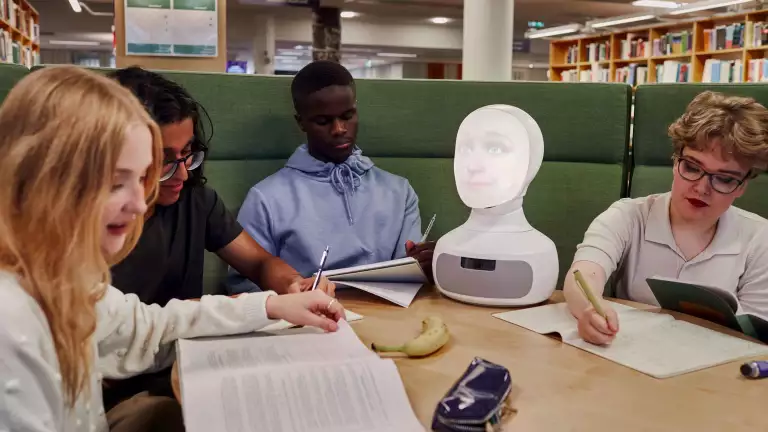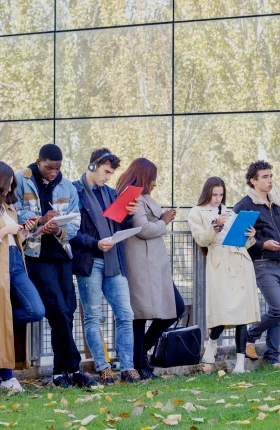Recent advancements in generative AI (GenAI) and the rise of ChatGPT, Bard, and many other models have catalyzed a new wave of interest in the field of artificial intelligence and its potential impact on a variety of sectors. Few will be more impacted than higher education, with its focus on research and the creation and transmission of knowledge and skills.
Across all industries, equal measures of excitement and anxiety are accompanying these rapid changes; however, the concern seems particularly acute in higher education. Educators and administrators are being compelled to react quickly to a technology that can reshape research, writing, and individual program areas. And incidents of students using ChatGPT improperly is not making their jobs any easier.
The dawn of the Internet Age nearly three decades ago presented higher education with enormous changes—and it rose to the challenge. Similarly, GenAI invites colleges and universities to not only adapt, but to leverage the promise of these technologies to unlock greater value in a variety of areas from recruitment marketing and student experience to faculty workload and intellectual property.
Based on our research and discussions with clients, and given our broad expertise in education and technology, we have identified five major ways that higher education can leverage GenAI. We offer ideas for how institutions can navigate this journey as well as promising practices from early adopters.
Development of hyper-personalized marketing and recruitment strategies.
GenAI is opening an unprecedented pathway into hyper-personalized marketing and advertising, and BCG is tracking use cases across several sectors. In consumer media, GenAI has applications across the entire customer value chain and is a powerful tool for optimization, identifying customer segments and building advertising campaigns around those characteristics. Various GenAI platforms can help to produce low-cost, personalized marketing content across text, images, and audio, driving increased engagement and interaction. GenAI can also be used to provide insights on audience preferences and behaviors and then generate personalized sales pitches.
The implications for higher education are clear—and potentially game-changing. With student populations in decline and recruitment costs often exceeding $4,000 per student, colleges and universities need innovative, low-cost strategies to reach their enrollment goals. Through hyper-personalization, GenAI holds the key. For example, having identified that a prospective student is involved in local sustainability programs, GenAI can generate outreach content specifically for this student, highlighting the college’s environmental science programs, campus recycling and composting activities, and any relevant student advocacy groups.
Using data provided by prospects, GenAI can drive customized engagement throughout a candidate’s journey. Increasingly sophisticated GenAI-powered chatbots can offer personalized admissions conversations and coaching for prospective students. The tools could be utilized to quickly answer student questions throughout the admissions process as the AI can be trained to generate institution-specific responses. As we look at consumer goods companies that are taking similar approaches to increase conversion rates, we see this as an exciting use case for higher education.
Improved student engagement and outcomes.
GenAI is seeding a transformation in student advising and engagement to improve persistence, retention, and completion rates—all of which are increasingly important to institutions in light of public and regulatory scrutiny of student outcomes as well as top- and bottom-line financial pressures.
Advisor and administrator tools have already begun to leverage AI and GenAI to drive step-change improvements in efficiency and effectiveness. For example, predictive early-alert systems are enabling proactive identification of at-risk students and informing personalized interventions. Automation of repetitive, rules-based tasks across activities like case management and degree planning are freeing up advisors to spend more time engaging with students. The potential of such tools to improve student advising is meaningful given the direct correlation between effective advising and persistence rates.
In parallel, there is an opportunity for GenAI to improve student-facing tools by providing the right information at the right time—and promoting the right associated action—all in one place. There are currently over 100 applications addressing core advising functionalities, and each institution typically deploys multiple solutions. As a result, students must piece together information from several sources to answer basic but important questions like, “Am I registering for the right number of credits, given the part-time job I recently took to cover a change in my financial aid status?”
GenAI chatbots could be used to help students get direct, instantaneous answers to questions on core advising topics using one centralized tool.
Conversational chatbots could be used to consolidate functionalities so students can get direct, instantaneous answers to their questions using one centralized tool. Furthermore, the chatbots could evolve to get ahead of such questions—for example, proactively alerting students of upcoming add/drop deadlines and guiding them through next semester’s registration process.
As GenAI “learns” to answer “should I” questions, these tools will be able to provide increasingly expansive advice: from real-time course recommendations based on factors such as major requirements, prior academic performance, and faculty ratings to suggestions on co-curricular commitments based on career preferences and course load. The associated lift in student engagement from this kind of real-time support is expected to impact student outcomes both directly and indirectly (for example, by enabling advisors to focus on students with the greatest need)
In the near-term, having a “human in the loop” will be necessary to confirm quality of responses, especially in higher risk activities like course planning and financial aid. However, the potential of these tools to enable broader access to more proactive, holistic student support and foster deeper student engagement is substantial.
Enhanced course planning and curricula.
So far, the use of GenAI tools in the classroom has had a mixed reception. One promising use case is leveraging the technology to enhance and accelerate the course planning process—freeing up time for faculty to focus on instruction, student support, and their own research agendas.
In its present form, GenAI is particularly well-suited to synthesizing large volumes of information, which can greatly assist educators in course development. For example, imagine an Intro to Biology professor planning next semester’s course. Within minutes, they could ask ChatGPT to develop a syllabus, curate a list of relevant books for students, and write detailed lesson plans based on available data. The professor could also use ChatGPT to easily find new reports, papers, and media to spruce up older lecture decks (within the limits of ChatGPT’s data, which as of this writing ran through September 2021).
Beyond near-term uses for course planning, GenAI can be leveraged by vendors to develop digital courseware that supports delivery of the course. GenAI can take courseware to the next level through personalized content; dynamic adjustment of format, level, and pace based on student progress; immersive, collaborative inputs from learner groups; and interactive experiences that improve student engagement and knowledge retention. For example, imagine GenAI-enabled courseware that offers a podcast-style version of the class material for a student who is more geared toward auditory learning than reading a textbook. While accessing the data required to pull this off is still challenging, it’s an intriguing vision that is much closer than ever before.
As AI tools are still “learning” and continue to be refined, they should not be used on their own for lesson planning and courseware development: today the output is at best a rough outline that must be enriched and refined by humans. GenAI is, however, a good starting point for these tasks—allowing faculty more time for creative thinking, design, research, and improving education quality for students. And who knows where the technology may take us: with OpenAI’s recent announcement that this year it will build and release the “Open AI Academy,” envisioned as a broad and free selection of courses and student supports, the possibilities seem endless. Nevertheless, it remains to be seen whether any of the content produced with the assistance of GenAI will be superior to (or even nearly as good as) what is already available via commercial publishers or the open educational resources from organizations such as OpenStax and Lumen Learning.
Teaching students to use GenAI.
The potential capabilities of GenAI and large language models (LLMs) have already begun to impact several industries and practices. Undeniably, LLMs are here to stay and will have a hand in shaping the future of jobs, education, and career preparation. Teaching students how to use GenAI to their advantage in their professions—particularly cohorts with careers that are projected to have high exposure to GenAI—can equip future workers with the skills to supercharge their capabilities. These skills, from prompt engineering to ethics, will help workers differentiate themselves in the market and increase their own productivity.
Teaching students how to use GenAI in their professions can equip future workers with the skills to supercharge their capabilities.
In March 2023, OpenAI, the research laboratory behind the GPT language models, released a working paper predicting the top industries that are most likely to be exposed to ChatGPT. The authors depict “exposure” as human access to LLM technology that would reduce time spent on a task by at least 50%. According to Open AI, the top three exposed job industries are:
- Securities, Commodity Contracts, and Other Financial Investments and Related Activities (55% exposure)
- Insurance Carriers and Related Activities (52% exposure)
- Computing Infrastructure Providers, Data Processing, Web Hosting, and Related Services (52% exposure)
BCG analysis compared OpenAI’s report to US Bureau of Labor Statistics and university completions data to estimate GenAI’s potential impact on the future job landscape. It was found that in the 2020–21 academic year, 22% of completions at US degree-granting institutions belonged to individuals on track to enter high-exposure industries and occupations. Of the 5.02 million degree and certificate-level completions from 4,077 degree-granting institutions, 1.14 million are associated with a highly exposed job industry based on OpenAI’s research.
With educational institutions hiring more faculty with AI expertise, there is potential for cross-subject integration of AI in student learning to provide them with the tools to remain competitive in changing industries. Imagine, for example, a computer science professor encouraging students to use GenAI tools to check their code for mistakes, or a history instructor teaching students how to engineer the specific AI prompts necessary to generate a quality first draft outline of a research paper. Developing strategies to use and master GenAI while still in an educational context can mitigate potential negative impacts in the labor market, while simultaneously opening up new opportunities for students who become workers.
Enhanced assessment and feedback for students.
Widespread student use of GenAI—both proper and improper—will force education institutions to rethink how they evaluate students in a future where these tools are prevalent. Just as the ease of online research reduced emphasis on the need for students to memorize key dates, we are moving to a future where research and information synthesis give way to critical thinking and practical problem solving. Creativity, leadership, ethical decision-making, new interpretations of data—these are all ways that student learning will be assessed in the future.
Evaluation formats have already begun to anticipate and adapt to how students will apply GenAI in the workplace after graduation—and to test those
Given the new skills that will be taught, it is important to expand approaches to assess student performance, from breaking down problems to evaluate and build on interpretations, to creating collaborative, project-based evaluations and real-world simulations. Imagine a classroom in which GenAI tools are regularly used to synthesize large volumes of information, but student learning is tested through “live” methods: defending an argument at the whiteboard or demonstrating mastery through handwritten responses. The higher-order skills that students stand to gain in the age of AI learning will serve them well in a new world of work. It is critical that colleges and universities develop appropriate assessment and feedback measures to ensure student mastery.
These are just a few of the myriad ways in which generative AI will impact higher education—many of which are unpredictable given the rapid pace at which this evolving technology is being adopted. Educational institutions should think carefully about the potential applications of the technology and how it may affect various aspects of the organization. In the near term, we encourage staff and administrators to choose applications that are low-cost and low-risk to build trust within and inspire their communities. Over time, they can deploy tools for high-value use cases, even if this requires additional management.
Whatever the specific approach, colleges and universities that are not proactive in learning about the potential of GenAI and fail to start integrating the technology into their operations will increasingly find themselves falling behind a curve that is sweeping students—and society—into a bold new future.
The authors wish to thank Khushbu Jagwani, Giancarlo Tassi, and Maria Vasington for research and writing assistance.








